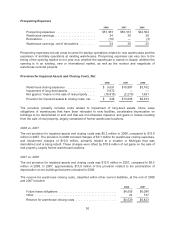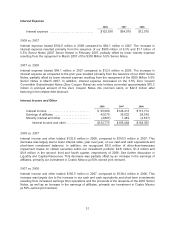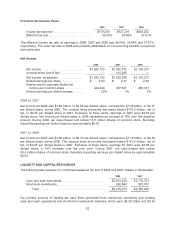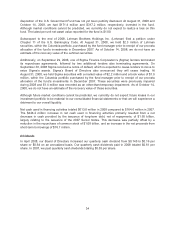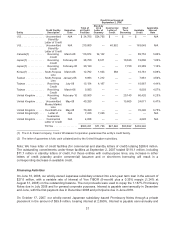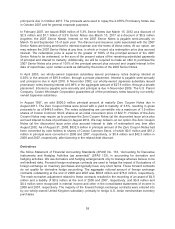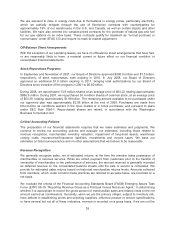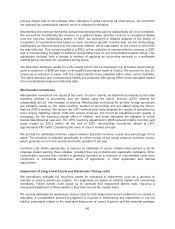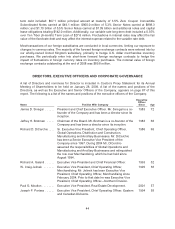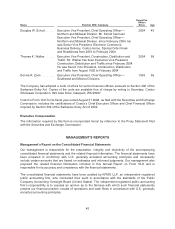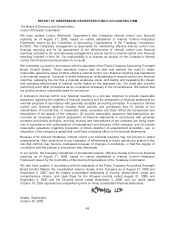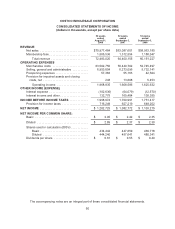Costco 2008 Annual Report Download - page 42
Download and view the complete annual report
Please find page 42 of the 2008 Costco annual report below. You can navigate through the pages in the report by either clicking on the pages listed below, or by using the keyword search tool below to find specific information within the annual report.primary obligor and do not possess other indicators of gross reporting as noted above, we record the
net amounts as commissions earned, which is reflected in net sales.
Membership fee revenue represents annual membership fees paid by substantially all of our members.
We account for membership fee revenue on a deferred basis, whereby revenue is recognized ratably
over the one-year membership period. In 2007, we performed a detailed analysis of the timing of
recognition of membership fees based on each member’s specific renewal date, as this methodology
represented an improvement over the historical method, which was based on the period in which the
fee was collected. This review resulted in a $56.2 million reduction to membership fee revenue in 2007
and a corresponding increase to deferred membership fees on our consolidated balance sheet. This
adjustment included both a change in method of applying an accounting principle to a preferable
method and a correction for cumulative timing errors.
Our Executive members qualify for a 2% reward (which can be redeemed only at Costco warehouses),
up to a maximum of $500 per year, on all qualified purchases made at Costco. We account for this 2%
reward as a reduction in sales, with the related liability being classified within other current liabilities.
The sales reduction and corresponding liability are computed after giving effect to the estimated impact
of non-redemptions based on historical data.
Merchandise Inventories
Merchandise inventories are valued at the lower of cost or market, as determined primarily by the retail
inventory method of accounting, and are stated using the last-in, first-out (LIFO) method for
substantially all U.S. merchandise inventories. Merchandise inventories for all other foreign operations
are primarily valued by the retail inventory method of accounting and are stated using the first-in,
first-out (FIFO) method. We believe the LIFO method more fairly presents the results of operations by
more closely matching current costs with current revenues. We record an adjustment each quarter, if
necessary, for the expected annual effect of inflation, and these estimates are adjusted to actual
results determined at year-end. The LIFO inventory adjustment in 2008 reduced ending inventory and
gross margin by $32.3 million. At the end of 2007, merchandise inventories valued at LIFO
approximated FIFO after considering the lower of cost or market principle.
We provide for estimated inventory losses between physical inventory counts as a percentage of net
sales. The provision is adjusted periodically to reflect results of the actual physical inventory counts,
which generally occur in the second and fourth quarters of the year.
Inventory cost, where appropriate, is reduced by estimates of vendor rebates when earned or as we
progress toward earning those rebates, provided they are probable and reasonably estimable. Other
consideration received from vendors is generally recorded as a reduction of merchandise costs upon
completion of contractual milestones, terms of agreement, or other systematic and rational
approaches.
Impairment of Long-Lived Assets and Warehouse Closing costs
We periodically evaluate our long-lived assets for indicators of impairment, such as a decision to
relocate or close a warehouse location. Our judgments are based on existing market and operational
conditions. Future events could cause us to conclude that impairment factors exist, requiring a
downward adjustment of these assets to their then-current fair market value.
We provide estimates for warehouse closing costs for both leased and owned locations to be closed or
relocated. A considerable amount of judgment is involved in determining any impairment or our net
liability, particularly related to the estimated sales price of owned locations and the potential sublease
40


